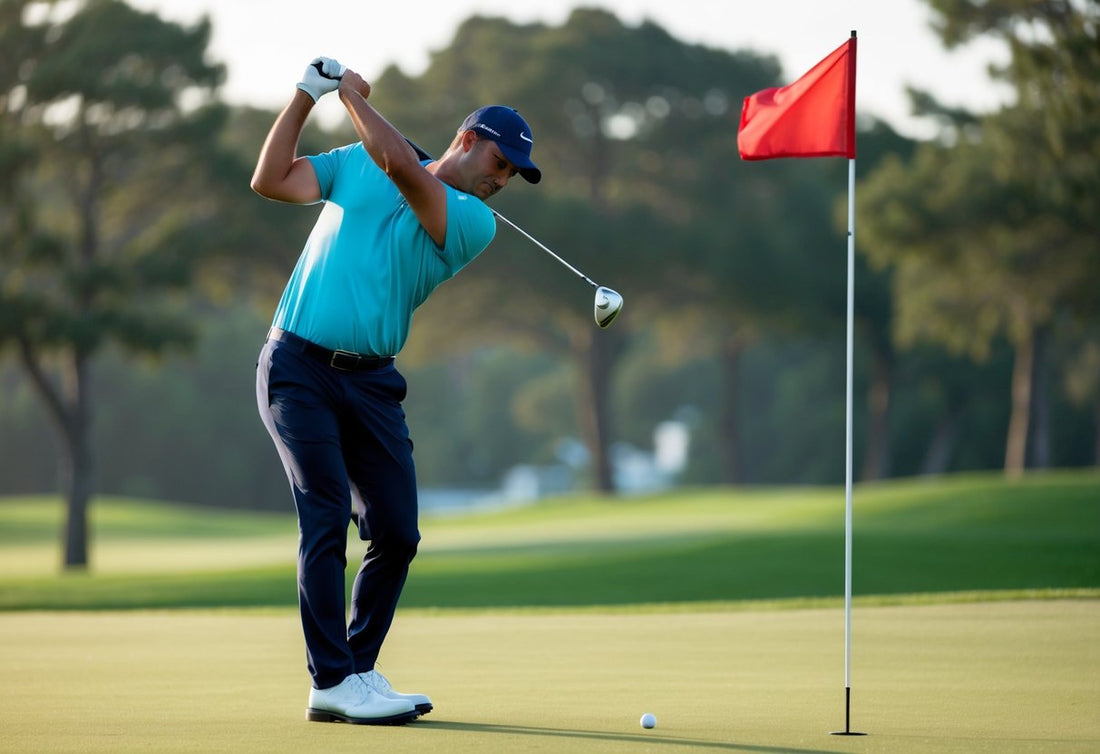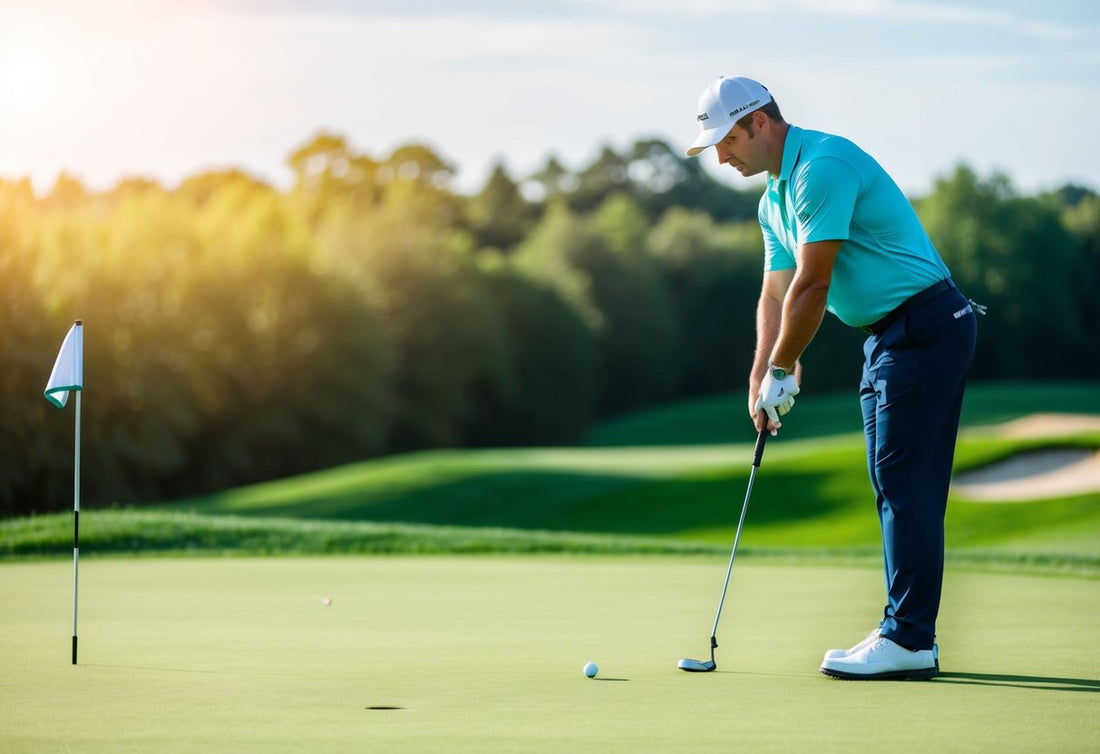Check out our golf rangefinders by Vovex to elevate your game!
Perfecting your golf swing is a journey that can transform your game. We've compiled essential tips to help you master the fundamentals and elevate your technique. A solid golf swing starts with understanding the key components: grip, stance, backswing, downswing, and follow-through.
Every golfer's swing is unique, but certain principles apply universally. By focusing on these core elements, you'll build a foundation for consistent and powerful shots. We'll guide you through each phase of the swing, offering practical advice to improve your form and boost your confidence on the course.
Remember, practice makes perfect. As you work on your swing, patience and persistence are key. Let's dive into the techniques that will have you hitting straighter, longer, and more accurate shots in no time.
Key Takeaways
- Mastering grip, stance, and posture sets the stage for a successful swing
- A smooth backswing and powerful downswing are crucial for distance and accuracy
- Mental preparation and regular practice drills lead to consistent improvement
The Grip: Foundation of a Solid Swing
A proper grip is crucial for achieving consistency and power in your golf swing. It serves as the only point of contact between you and the club, making it essential for control and accuracy.
Mastering the Lead Hand Placement
We start by placing our lead hand (left for right-handed golfers) on the club. The grip should run diagonally across our palm, from the base of our pinky to the middle of our index finger. This creates a 'V' shape between our thumb and forefinger, pointing towards our trailing shoulder.
For optimal control, we wrap our fingers around the club, ensuring our thumb rests slightly right of center on the grip. This position allows for maximum leverage and feel throughout the swing.
To check our grip strength, we should see two to three knuckles on our lead hand when addressing the ball. This neutral position helps promote a square clubface at impact.
Positioning the Trailing Hand for Control
Our trailing hand complements the lead hand, providing additional stability and power. We place it below the lead hand, with the lifeline of our palm fitting snugly over our lead thumb.
The 'V' formed by our trailing hand's thumb and forefinger should also point towards our trailing shoulder. This alignment ensures both hands work together seamlessly during the swing.
We avoid gripping too tightly with our trailing hand, as this can lead to tension and reduced clubhead speed. Instead, we maintain a firm but relaxed hold, allowing for natural wrist hinge and release through impact.
Interlocking vs. Overlapping: Choosing Your Style
The two most common grip styles in golf are interlocking and overlapping. In the interlocking grip, we intertwine our lead hand's pinky with the index finger of our trailing hand.
The overlapping grip, also known as the Vardon grip, involves placing the pinky of our trailing hand between the index and middle fingers of our lead hand.
We choose based on comfort and hand size. Golfers with smaller hands often prefer the interlocking grip for added stability. Those with larger hands may find the overlapping grip more natural.
Ultimately, consistency is key. We stick with the grip that feels most comfortable and allows us to maintain control throughout our swing.
Stance and Posture: Preparing for Success
A solid foundation is crucial for a great golf swing. Let's explore the key elements of stance and posture that set you up for success on the course.
Feet Alignment and Width for Stability
We start with our feet. For most shots, aim to position your feet shoulder-width apart. This provides a stable base for your swing. Align your feet parallel to the target line, with your toes pointing straight ahead.
For drivers and longer clubs, widen your stance slightly. With shorter clubs, a narrower stance works well. Practice finding the right width for each club in your bag.
Remember, proper alignment is key. Use alignment sticks on the practice range to perfect your foot position. This small detail can make a big difference in your shot accuracy.
Balancing Your Weight Effectively
Balanced weight distribution is vital for a consistent swing. Start with your weight evenly distributed between both feet. As you address the ball, shift slightly more weight to your front foot.
For most shots, aim for a 60/40 weight distribution favoring your front foot. This helps promote a downward strike on the ball.
During your backswing, your weight will naturally shift to your back foot. As you swing through, transfer your weight smoothly to your front foot. This weight transfer creates power and accuracy in your shots.
Setting the Right Posture
Good posture sets the stage for a smooth, powerful swing. Stand tall with your spine straight. Bend forward from your hips, not your waist. Keep your back straight throughout this movement.
Let your arms hang naturally from your shoulders. Flex your knees slightly for added stability and flexibility. Your chin should be up, allowing room for your shoulders to turn during the swing.
Maintain this athletic posture throughout your swing. It helps you rotate properly and transfer power from your body to the ball. Practice your posture in front of a mirror to develop muscle memory.
The Backswing: Starting Your Swing with Confidence
A proper backswing sets the foundation for a powerful and accurate golf shot. We'll explore the key components of rotating your body, lifting the club, and hinging your wrists to initiate a successful swing.
Rotating the Shoulders and Hips
To begin our backswing, we focus on turning our upper body. We start by rotating our shoulders away from the target. Our left shoulder (for right-handed golfers) should move down and back, while our right shoulder moves up and around.
As we turn, our hips also rotate, but to a lesser degree than our shoulders. This creates a coil effect, building potential energy for our downswing. We aim for about a 90-degree shoulder turn and a 45-degree hip turn.
It's crucial to maintain our spine angle throughout this rotation. We keep our head relatively still, allowing it to turn slightly with our shoulders.
Elevating the Club in the Right Arc
As we rotate our body, we simultaneously lift the club. We want to create a wide arc, extending our arms away from our body. This helps generate more power and improves our swing plane.
We keep our left arm (for right-handed golfers) relatively straight but not locked. Our right elbow should bend slightly, pointing towards the ground as we reach the top of our backswing.
The clubhead should trace an arc that stays outside our hands. This path helps ensure we're in a strong position at the top of our swing.
Setting the Wrist Hinge
The final piece of our backswing puzzle is the wrist hinge. As we lift the club, we allow our wrists to cock naturally. This hinge typically occurs when the club shaft is parallel to the ground.
We aim for about a 90-degree angle between our left forearm and the club shaft at the top of our backswing. This wrist position stores additional power and helps us maintain control of the club.
It's important not to force this hinge. We let it happen naturally as part of our swing motion. Over-hinging can lead to inconsistency and loss of power.
The Downswing: Unleashing Power
The downswing is where we generate power and accuracy in our golf shots. It's a critical phase that requires precise timing and coordination.
Initiating the Move with Lower Body
We start the downswing with our lower body. Our hips initiate the movement, rotating towards the target. This rotation creates a coiling effect, building potential energy.
As our hips turn, we shift our weight onto our lead foot. This weight transfer is crucial for power generation. We keep our upper body back momentarily, increasing the separation between our upper and lower body.
Our knees flex slightly, preparing for the explosive upward thrust that's to come. This lower body action sets the stage for a powerful strike.
Syncing Arms with Body Rotation
As our lower body rotates, we let our arms fall naturally into the slot. Our hands trace a path close to our body, promoting an inside-out swing path.
We keep our wrists cocked, maintaining the angle we created in the backswing. This lag stores power, ready to be released at impact.
Our lead arm stays close to our chest, connected to our body's rotation. We focus on turning our body rather than swinging our arms independently.
Driving Through the Ball for Maximum Impact
As we approach impact, we unleash the stored energy. Our hips continue rotating, pulling our shoulders and arms through the shot.
We maintain our spine angle and posture, resisting the urge to stand up. Our wrists begin to uncock, releasing the clubhead through the ball.
We drive our legs into the ground, creating an upward force. This helps us compress the ball and maximize distance. Our eyes stay focused on the ball until after impact.
After contact, we let our arms extend fully towards the target. We finish with our weight on our lead foot, chest facing the target, and our body in balance.
Impact and Follow-Through: The Moment of Truth
The impact position and follow-through are critical for a powerful, accurate golf shot. Let's explore the key elements to master this crucial phase of the swing.
Achieving a Square Clubface at Impact
At impact, our clubface should be square to the target line. We'll want to keep our hands ahead of the clubhead, maintaining the angle set at address. This promotes a downward strike on the ball, creating optimal spin and trajectory.
To practice, we can use alignment sticks on the ground to visualize our target line. We should focus on rotating our body through impact, rather than flipping our hands.
A drill to improve impact position: Place a tee just in front of the ball. Try to strike the ball first, then the tee. This encourages a proper downward angle of attack.
Maintaining Acceleration Through the Ball
Accelerating through impact is crucial for maximum power and distance. We must resist the urge to decelerate as we approach the ball. Instead, we should imagine swinging through to a point beyond the ball.
A helpful drill: Practice swinging with a whooshing sound that gets loudest just after where the ball would be. This trains us to accelerate through impact.
We can also try hitting shots with our feet together. This limits body rotation and forces us to rely on hand and arm acceleration through the hitting zone.
Finishing with a Full, Balanced Follow-Through
A full, balanced follow-through indicates we've maintained speed through impact. We should aim to finish with our weight on our lead foot, chest facing the target, and club wrapped around our back.
To practice balance, we can try hitting shots while standing on our lead foot only. This exaggerates the feeling of transferring weight forward through impact.
Another drill: After impact, hold our finish position for a three-count. This helps ingrain the feeling of a complete, balanced follow-through.
Managing Risk vs. Reward Scenarios
We must weigh the potential benefits against the risks in every situation. When we're trailing in a match, taking calculated risks might be necessary. However, if we're leading, a more conservative approach could be prudent.
Par 5s often present risk-reward decisions. We might consider going for the green in two if we have a favorable lie and wind conditions. But if there's trouble around the green, laying up could be the smarter play.
Short par 4s can tempt us to drive the green. We should assess our driving accuracy and the consequences of missing before making this choice. Sometimes, a well-placed iron off the tee sets up an easier approach shot.
Mental Approach: Keeping Your Cool
A strong mental game is crucial for success on the golf course. We'll explore techniques to visualize success, stay calm under pressure, and develop an effective pre-shot routine.
Visualizing Successful Shots
Visualization is a powerful tool in golf. Before each shot, we take a moment to picture the perfect outcome. We see the ball's trajectory, its landing spot, and even hear the satisfying sound it makes.
This mental rehearsal boosts our confidence and improves our focus. We practice visualization off the course too, imagining successful rounds in our mind's eye. Over time, this technique strengthens our belief in our abilities.
Visualization works best when it's detailed and vivid. We engage all our senses, feeling the club in our hands and the grass beneath our feet.
Staying Calm Under Pressure
Pressure can derail even the most skilled golfers. We combat nerves by focusing on our breathing. Deep, slow breaths help calm our minds and relax our muscles.
We also use positive self-talk to maintain composure. Instead of dwelling on potential mistakes, we remind ourselves of past successes. Phrases like "I've made this shot before" or "I trust my swing" can work wonders.
Another effective strategy is to embrace the challenge. We view pressure situations as opportunities to showcase our skills rather than threats to avoid.
Developing a Pre-Shot Routine
A consistent pre-shot routine anchors us mentally and physically. We start by assessing the lie, wind conditions, and target. Next, we take a few practice swings to groove our intended motion.
As we address the ball, we follow the same sequence each time. This might include aligning our feet, taking a deep breath, and giving one final look at the target. Our routine should feel natural and take no more than 30 seconds.
A solid pre-shot routine helps us stay focused and blocks out distractions. It also triggers our muscle memory, allowing us to execute shots more consistently.
Practice Drills: Sharpening Your Skills
Consistent practice is key to improving your golf swing. Let's explore some effective drills and habits to elevate your game.
Creating Effective Practice Habits
We recommend setting aside dedicated practice time each week. Start with short, focused sessions of 30 minutes to an hour. Quality trumps quantity when it comes to golf practice.
Break your practice into specific skill areas. Spend time on putting, chipping, and full swings separately. This targeted approach helps refine each aspect of your game.
Use alignment sticks during practice to check your stance and swing path. They're a simple yet powerful tool for maintaining proper form.
Utilizing Feedback for Immediate Improvement
Video analysis is a game-changer for many golfers. We suggest recording your swings regularly and reviewing them to spot areas for improvement.
Consider using launch monitors or simulators for detailed swing data. These tools provide insights on club head speed, ball spin, and launch angle.
Don't hesitate to seek feedback from a golf pro. Even a single lesson can offer valuable tips to enhance your technique.
Incorporating Golf Fitness into Your Routine
Strength training focused on core and leg muscles can significantly boost your swing power. We recommend exercises like squats, lunges, and planks.
Flexibility is crucial for a fluid golf swing. Include stretches for your shoulders, hips, and back in your daily routine.
Balance exercises, such as single-leg stands, improve stability during your swing. Practice these regularly to enhance your overall performance on the course.
Remember to warm up before each practice session or round. A proper warm-up reduces injury risk and prepares your body for optimal performance.
Frequently Asked Questions
Perfecting your golf swing takes practice and attention to key fundamentals. Let's address some common questions to help you improve your technique.
What drills can help improve my beginner golf swing?
We recommend starting with the "wall drill" to work on your alignment. Stand with your back against a wall and practice your swing motion without hitting a ball. This helps develop muscle memory for proper form.
Another effective drill is the "towel drill." Place a towel under your arms and against your chest, then practice swinging while keeping the towel in place. This promotes a connected swing and better rotation.
How can I ensure proper grip and posture before taking a swing?
For grip, we suggest the "V" method. When you look down at your hands on the club, the creases between your thumbs and index fingers should form a "V" pointing towards your right shoulder (for right-handed golfers).
To check posture, stand tall with your feet shoulder-width apart. Bend forward from your hips, keeping your back straight. Let your arms hang naturally. This position forms the basis of a good golf stance.
Can you break down the golf swing into key stages for better understanding?
The golf swing can be divided into four main stages:
- Setup: Proper grip, alignment, and posture
- Backswing: Rotating your shoulders and hips away from the target
- Downswing: Shifting weight and rotating towards the target
- Follow-through: Completing the rotation and finishing balanced
Focus on mastering each stage individually before combining them into a fluid motion.
How do I maintain consistency in my golf swing technique?
Consistency comes from repetition and muscle memory. We advise setting aside regular practice time, even if it's just 15 minutes a day. Use alignment sticks during practice to ensure your setup is consistent each time.
Video yourself swinging and compare it to pro swings. This visual feedback can help you identify areas for improvement and track your progress over time.
What are the common mistakes to avoid for a more effective golf swing?
Some frequent errors include:
- Gripping the club too tightly, which restricts wrist movement
- Swaying instead of rotating during the backswing
- Lifting the head before impact, leading to poor contact
- Overswinging, which can throw off balance and timing
How often should I practice my golf swing to see noticeable improvement?
We suggest practicing at least 2-3 times a week for noticeable improvement. Quality is more important than quantity. Focus on deliberate practice, working on specific aspects of your swing each session.
Use a mix of full swings and short game practice. Incorporate drills that target your weak areas. Remember to take breaks to avoid fatigue and maintain good form throughout your practice sessions.






